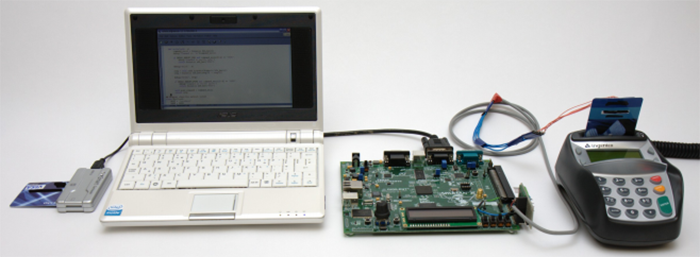Back in the day, true hackers – the kind that would build VCRs out of 555 chips only to end up in the Hackaday comments section in their twilight years – would steal satellite TV feeds with the help of tiny little microcontrollers embedded in a credit card. This was the wild west, when a parallel port was the equivalent of a six-shooter and Jnco jeans were a ten gallon hat.
The backdoors that enabled these satellite pirates have long been closed, but these devices for stealing HBO have now evolved into stealing €600,000 worth of goods using a most unlikely source: chip and pin card terminals. A gang of criminals in Belgium have successfully broken chip and pin, and although the exploit has now been closed, the researchers behind the investigation have published their war story for one of the most interesting hacks in recent memory.
Chip and pin verification for Point of Sale (PoS) transactions are a relatively simple process; during a transaction, the PoS system asks for the user’s PIN and transmits it to the card. The card then simply answers ‘yes’ or ‘no’. In 2010, a vulnerability to this system was discovered, making it a simple matter for anyone to break chip and pin systems. This system used an FPGA with a backpack worth of modified hardware – executing it in a store would raise more than a few eyebrows.

The problem of implementing this system into something that was easily concealable was simply a matter of miniaturization. Thanks to the proliferation of smart cards over the last 20 years, very tiny microcontrollers are available that could manage this man-in-the-middle attack on a chip and pin system. What is a gang of criminals to do? Simply program a smart card with all the smarts required to pull of the hack, of course.
To pull off this exploit, an engineer in the gang of criminals used a FUNcard, a development platform for smart cards loaded up with an Atmel AVR AT90S8515 microcontroller and an EEPROM packaged in a small golden square. By removing the chip from this chipped card and replacing the chip in a stolen credit card, the criminals were able to reproduce the 2010 exploit in the wild, netting them €600,000 in stolen merchandise before they were caught.
How were they caught? The ‘buyer’ of the gang kept shopping at the same place. Rookie mistake, but once security researchers got their hands on this illegal hardware, they were amazed at what they found. Not only did the engineer responsible for this manage to put the code required for the exploit in an off-the-shelf smart card, the gold contact pads from the original credit card were rewired to the new microcontroller in an amazing feat of rework soldering.
Before this exploit was made public, the researchers developed a countermeasure for this attack that was swiftly installed in PoS terminals. They also came up with a few additional countermeasures that can be deployed in the future, just in case. In any event, it’s an amazing bit of reverse engineering, soldering, and craftsmanship that went into this crime spree, and as usual, it only took a massive loss for retailers to do anything about it.











